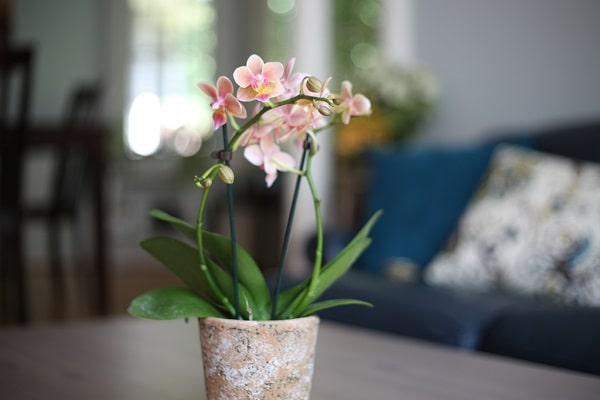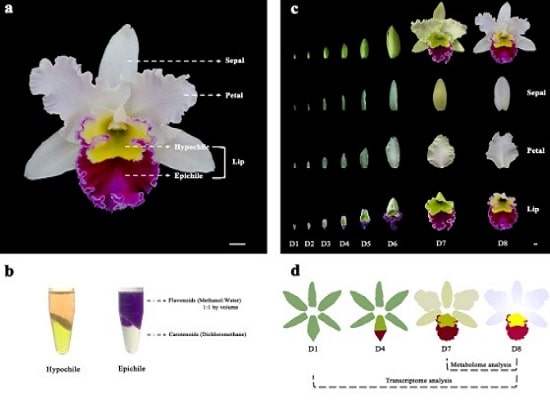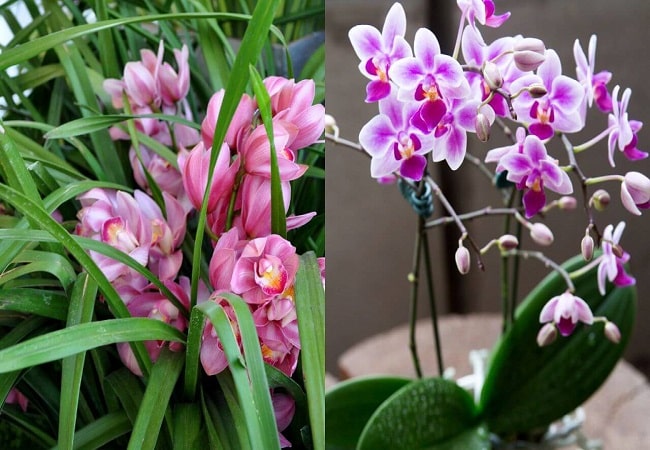Orchids are a large and diverse group of flowering plants. We know of more than 25,000 different kinds of orchids. Cymbidium orchids vs. phalaenopsis a comparison People like them because their beautiful flowers come in many colors, shapes, and sizes. Orchids are popular houseplants but are also grown for sale as cut flowers and in pots.
I’ll compare phalaenopsis and cymbidium orchids in this post. Cymbidium orchids are endemic to Asia and have long-lasting, beautiful blossoms. Phalaenopsis orchids are tropical and easy to care for.
I shall compare these two orchids’ looks, cultural needs, and remarkable aspects. You’ll know which orchid is perfect for your house or garden at the end of this piece.
Quick Navigation
Cymbidium Orchids vs. Phalaenopsis A Comparison Overview
| Botanical Name | Cymbidium |
| Common Name | Cymbidium orchid, boat orchid |
| Plant Type | Evergreen flower |
| Adult Size | Around 2 feet tall |
| Soil Type | Loamy, moist, well-draining |
| Soil pH | 5.5 to 6.5 |
| Bloom Time | Mid-autumn to mid-spring |
| Flower Color | Pink, green, yellow, and white |
| Hardiness Zones | 10 to 12 |
| Native Area | Asia and Australia |
Cymbidium orchid is a flowering plant in the family Orchidaceae. They are also called “boat orchids.” They are native to Asia, Australia, and the Pacific Islands. They are widely cultivated in many parts of the world for their beautiful, long-lasting flowers.
Cymbidium orchids have long, narrow leaves and tall, sturdy stems that can grow up to 3 feet in height. The flowers are typically large and showy and come in various colors, including white, yellow, pink, and red. They are often used in potted plants and flower arrangements.
Cymbidium orchids prefer a cool climate and do best when grown in indirect sunlight or partial shade. They require well-draining soil and are watered regularly but can dry out slightly between waterings. They can fertilize with a balanced orchid fertilizer once a month during the growing season.
Cymbidium orchids are propagated by dividing the plant or using tissue culture techniques. They can also grow from seed, but this is a slower and more complicated process.
In general, cymbidium orchids are low maintenance and a lovely addition to any house or garden.
Overview Of Phalaenopsis Orchids

| Botanical Name | Phalaenopsis |
| Common Name | Moth orchid |
| Plant Type | Monopodial epiphytic and lithophytic herbs |
| Adult Size | Up to 3 feet high and 1-foot broad |
| Soil Type | Moist, well-draining |
| Soil pH | 5 to 6 |
| Bloom Time | Late winter through the spring |
| Flower Color | Red-purple, purple, purple-violet, violet, and violet-blue |
| Hardiness Zones | 10 to 12 |
| Native Area | India, southern China, and Southeast Asia |
Phalaenopsis orchids, also known as moth orchids, is a flowering plant in the Orchidaceae family. Their long-lasting blossoms are cultivated worldwide from Southeast Asia to the Pacific Islands.
Phalaenopsis orchids have long, slender leaves and tall, branching stems that can grow up to 3 feet. The flowers are typically large and showy and come in various colors, including white, pink, purple, and yellow.
Phalaenopsis orchids do best when kept in a warm, humid place with indirect sunlight or partial shade. They need soil that drains well and is watered often but given a little time to dry out between waterings. You can give them a balanced orchid fertilizer once a month during the growing season.
Tissue culture or division can propagate Phalaenopsis orchids. Growing them from seed is slower and more complex.
Overall, phalaenopsis orchids are relatively easy to care for and make a beautiful addition to any garden or home.
Similarities Between Cymbidium and Phalaenopsis Orchids

There are several similarities between Cymbidium and phalaenopsis orchids:
- Both orchids are epiphytic, which means they grow on other plants or objects rather than in soil. They are adapted to growing in the crooks of tree branches or on rocks and are found in tropical and subtropical regions.
- Cymbidium and phalaenopsis orchids have long, upright flower stems and produce showy flowers that come in various colors. The flowers of both orchids can last for several weeks or even months.
- Cymbidium and phalaenopsis orchids are relatively easy to care for and are famous for both beginner and experienced gardeners. They watered regularly but were allowed to dry out slightly between watering to prevent root rot.
- Both orchids are adaptable to a wide range of environments and grown in pots, baskets, or mounted on slabs of wood or cork. They can grow indoors or outdoors in a well-draining soil mix and a spot with dappled sunlight.
- Cymbidium and phalaenopsis orchids are both relatively resistant to pests and diseases. They are known for their long-lasting flowers, making them popular among gardeners and enthusiasts.
Differences Between Cymbidium And Phalaenopsis Orchids
There are several differences between cymbidium and phalaenopsis orchids in terms of their physical characteristics, cultural needs, and growing habits:
Physical Characteristics:
- Cymbidium orchids have more significant, showy flowers produced in clusters on long, upright stems. They come in many colors: white, yellow, pink, red, and green.
- Phalaenopsis orchids have smaller, more delicate flowers on long, upright stems. They come in various colors, including white, pink, purple, and yellow.
Cultural Needs:
- Cymbidium orchids prefer a temperature range of 55-80°F (13-27°C). They can grow in various environments, including greenhouses, outdoor gardens, and indoor plants.
- Phalaenopsis orchids prefer a temperature range of 60-80°F (16-27°C) and are typically grown as indoor plants.
Growing Habits:
- Cymbidium orchids are known for their long-lasting flowers, which can remain in bloom for several weeks or even months.
- Phalaenopsis orchids are also known for their long-lasting flowers. Still, they produce multiple colors per season, with some plants growing numerous flowers on a single stem simultaneously.
Most Commonly Asked Questions
Why Are Phalaenopsis So Popular?
Phalaenopsis orchids are popular because they are relatively easy to care for, have long-lasting flowers, produce multiple blooms per season, are adaptable to various environments, and are resistant to pests and diseases. These factors make them a popular choice for both beginner and experienced gardeners.
How Do You Know Which Type Of Orchid You Have?
There are over 25,000 species, and it is challenging to identify the specific type of orchid you have. Here are a few tips for determining the kind of orchid you have:
- Look for identifying characteristics: Each variety of orchids has unique physical features that can help you identify them. These characteristics may include the flowers’ size, shape, and color, the shape and size of the leaves, and the plant’s overall size and growth habit.
- Consult a guide: Many books and online resources can help you identify different orchids. These resources often include detailed descriptions and photographs of other orchid species, making it easier to compare your plant to the images provided.
- Ask an expert: If you still need to identify your orchid after consulting a guide, consider asking a local orchid expert or joining an orchid forum or group online. These individuals and communities can often provide more specific information and guidance for identifying different types of orchids.
How Many Times A Year Do Phalaenopsis Bloom?
Phalaenopsis orchids are known for their ability to produce multiple blooms per season. The number of flowers a phalaenopsis orchid makes per year can vary depending on the care and conditions under which the plant is grown.
In general, phalaenopsis orchids will produce at least one or two blooms yearly, but some plants may have more. The timing of blooms can also vary, with some plants making flowers in the spring and summer while others may bloom in the fall or winter.
Which Orchid Blooms Continuously?
Several types of orchids are known for their ability to produce continuous blooms throughout the year. These include
- Oncidium orchids: Oncidium orchids are from Central and South America, and their flowers are known for being beautiful and fragrant. Some varieties of oncidium orchids are known to produce continuous blooms throughout the year when provided with proper care and conditions.
- Dendrobium orchids: Dendrobium orchids, native to Asia and the Pacific Islands, with long, thin stems and clusters of small, multicolored flowers. With bright, indirect light, frequent watering and fertilization, and a well-draining potting mix, dendrobium orchids can blossom continually.
- Cattleya orchids: Central and South American Cattleya orchids have enormous, beautiful blossoms. Cattleya orchids bloom year-round with six-week-long blooms.
- Vanda orchids: Vanda orchids are from Southeast Asia, and their long, straight flower stems and showy flowers are what make them famous. Some kinds of vanda orchids bloom all year long if they get the proper care and are in the right environment.
In Summary
Cymbidium and Phalaenopsis orchids are famous for their large, showy flowers and easy care. They have different physical characteristics, cultural needs, and growing habits and can grow in various environments. Both orchids are easy to take care of and don’t get bugs or diseases very often.
This makes them popular choices for gardeners and plant lovers. When choosing an orchid to add to your collection, you should consider how both cymbidium and phalaenopsis orchids are different and choose the one that fits your needs and tastes the best. Both orchids are beautiful and can add a touch of elegance and beauty to any home or garden.

My name is Md Robiul Islam and I’m a plant enthusiast. I like to have a garden and research different plants. I also have an interest in environmental science and would like to work in that field in the future.


